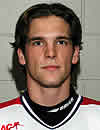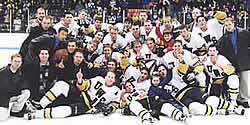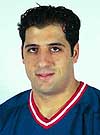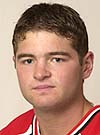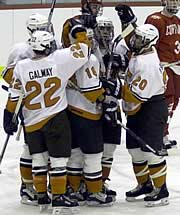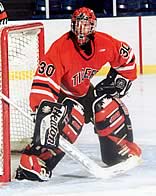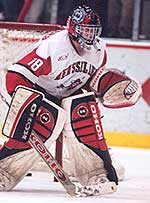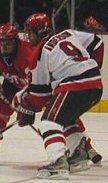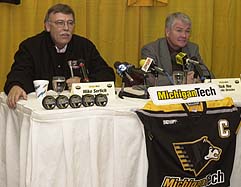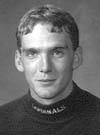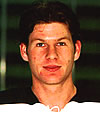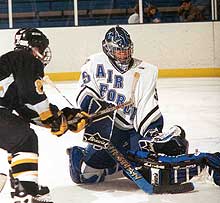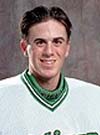Higher Stakes Highlight Fight to the Finish
This ain’t your grandparents’ MAAC playoffs.
How’s that for stealing half of a good expression only to ruin it?
Fact of the matter is, though, it’s true. What started as 11 teams five-plus months ago is now down to eight. The state of Massachusetts, and thus the teams in it, won’t contend this year for the MAAC championship.
No, there’s not a Bay State boycott, or even a snow-in from this past week’s storm that rocked the greater Boston area. It just happens to be that the three teams that won’t make the MAAC playoffs this season are Bentley, Holy Cross and AIC — Massachusetts’ three entries.
But the eight remaining clubs will have the chance to fight to the finish — well, at least until the 60 minutes (barring overtime) runs out each game, to be crowned this year’s MAAC champion.
And yes, though we’ve talked about it ad nauseum, one cannot forget that the stakes have been raised. The survivor of the eight will become the MAAC’s first entry into the NCAA Ice Hockey Championships.
Almost as a prelude to the fact that the MAAC playoffs will be a dogfight, even the final week of the regular season went to the wire to find the last of the eight contenders. With AIC holding the slimmest of leads — one point — over Fairfield, each team played a tough closing schedule, with Fairfield hosting Mercyhurst and Canisius, and AIC in a home-and-home with Iona.
The Stags looked on Friday night as if they’d pull into a tie with AIC, taking Mercyhurst to overtime. But Mercyhurst’s Mike Carter scored a miraculous goal with one second remaining in overtime, after a Tim Veins penalty for unsportsmanlike conduct was whistled at 4:54. All of this after Fairfield has squandered leads of 1-0 and 2-1. With AIC’s loss at Iona, Fairfield looked like they had missed an opportunity.
But instead of packing lockers and making plans for spring break, the Stags came back on Saturday night and upset Canisius, the third seed in the upcoming tournament, 7-5.
“We knew we needed three out of four points to keep our fate in our hands,” said Fairfield coach Jim Hunt. “We came so close in the first night. Tim Viens made a not-so-smart move to mouth off to the ref [in the closing minutes] and it cost us. But then we addressed the issue at hand and moved on.”
Saturday had all the makings for a repeat performance of Friday’s disaster when Canisius tied the game at three just seconds into the third period. But Fairfield responded 22 seconds later when Dan Cotter scored, igniting a four-goal outburst over the next 4:35. Even though the Griffs rallied for two goals late, it wasn’t enough. Fairfield had done its part to make a step towards the MAAC tournament.
“Fairfield played real tough on Saturday,” said Canisius coach Brian Cavanaugh. “We had battled back and then they scored three or four goals in three or four minutes.”
At that point, an hour’s wait was all that Fairfield needed before finding out that AIC had dropped the season finale to Iona, 4-2, and that the Stags, winners of four of their last six, had a berth in the tournament.
Though Fairfield’s weekend drama was exciting, it wasn’t the only nail-biting script. Ironically, the other involved Canisius as well. But unlike Saturday when the Griffs fell to help Fairfield’s berth, Friday night, Canisius dampened the hopes of Sacred Heart for getting home ice.
Facing a must-win situation, Sacred Heart went to overtime before succumbing to the Griffs. But it wasn’t your typical goal that won this game. Knowing that a tie would do his club no good, Sacred Heart coach Shaun Hannah pulled goaltender Eddy Ferhi with 1:14 remaining in overtime. Though the Pioneers pressured the Canisius net, Chris Duggan finally broke through with six seconds left, scoring into the empty net to give Canisius the overtime win in rarest of forms.
“I give Shaun Hannah a lot of credit. [Pulling the goalie] was a gutsy move,” said Cavanaugh. “But he had worked out the formula beforehand and knew a tie against us did him no good.”
So with all of the action of the regular season complete — eight now remain. Mercyhurst, Quinnipiac, Iona and Canisius will be the host for the always-scary single-elimination playoff games this weekend. While Connecticut, Sacred Heart, Army and Fairfield will be the house guests.
Quarterfinals Preview
#8 Fairfield (11-18-2, 10-14-2 MAAC) at #1 Mercyhurst (19-11-2, 19-6-1 MAAC)
Saturday, March 10, 7:30 P.M. Mercyhurst Ice Arena
Season series: Series tied, 1-1
@ Mercyhurst 5, Fairfield 2
Mercyhurst 3, @ Fairfield 2 (OT)
For Mercyhurst and Fairfield, facing one another on the ice is at least familiar, as the two clubs battled just this past weekend. But when they square off this weekend in Erie, Penn., don’t expect too much to feel the same.
Besides the change in venue, with last week’s game played in Connecticut, Fairfield will also see a difference between the pipes for the Lakers, as starting netminder and MAAC goaltender of the year hopeful Peter Aubry will get the go ahead after getting a night off last weekend against the Stags.
That, though, isn’t enough to deter the confidence of Fairfield coach Jim Hunt.
“We’re playing our best hockey right now,” said Hunt. “Our kids know the systems and are at a competitive peak.
“Our game plan going in to last weekend was solid. I comfortable that the game plan that we put in last week will be effective in allowing us to compete on Saturday.”
Now a trip to Erie, Penn., probably isn’t the most appealing venue for playing a playoff game. But when you consider that Fairfield was one game away from not even having a playoff life, Erie now seems like Disney World.
“The kids are kind of joking that we’re going to Erie for spring break,” said Hunt. “They’re excited. No one is disappointed that we have to make an eight-hour trip on Friday.”
Now with probably enough talent to pull of a major upset, Fairfield is still without one thing: playoff experience. The Stags didn’t qualify for the playoffs last year, and their trip two years ago, a season in which the club won only one game all year, was as short as could be.
“We don’t have much MAAC playoff experience,” Hunt said. “But the fact that we’ve got some older freshmen and sophomores who have played in big games throughout their career is where we have to draw from.”
One of those sophomore, Ryan Tormey, though will be missing from the lineup this weekend. Having suffered two concussions in a four-week period, a conscious decision was made to rest the young winger.
“We made the decision collectively with he neurologist and his family and Ryan,” said Hunt. “We’re not going to expose him to any more potential danger right now.”
On the other side of the coin, Mercyhurst will be ready with its full compliment of players on Saturday, returning two key players — Tom McMonagle and Jody Robinson — both of whom missed action last weekend.
They, though, will be the team with the most pressure, being the top seed in this tournament in the always scary one-and-done format.
“We’ve tried to build up the pressure all year for our guys — we know all about the one-game elimination,” said Mercyhurst coach Rick Gotkin, who all year has preached that the next game is the biggest, and now will literally live that. “The pressure of trying to win the regular season championship towards the end was healthy. So we feel we’re pretty good at playing with the pressure.”
Gotkin, though, couldn’t help but discuss his dislike for the current MAAC playoff format.
“The playoff structure clearly favors the underdog. The bounce of a puck here or there could be the difference,” said Gotkin. “Whether we’re one seed or eight seed, I’d still like to see a two-out-of-three tournament.
“You work so hard all year to get in the top four and what do you really get for that? You get a home game that for us is nice for our geographical location. But how do you reward the top teams?
“I suppose it’s exciting, but I think there should be more of a reward for those top four teams.”
As fearless as Gotkin may be, it’s easy to understand why there is a lot of pressure on his Lakers. Unlike the first season when the top and bottom of the MAAC were clearly different in terms of talent, the parity that currently exists could make the bottom of the league lick its chops and the top have nightmares.
“Someone asked me who I’d rather play,” said Gotkin, “and honestly, the bottom line is that any team in the MAAC, including those who missed the playoffs, are good enough to beat you. We’re going to have to play good hockey on Saturday night to get past this very good Fairfield team.”
Gotkin’s thoughts on what it will take to win?
“I think it’s going to come down to who gets great goaltending and who capitalizes on their offensive opportunities. Fairfield works very hard and they’re very committed to all three zones.”
But one line from Gotkin can pretty much sum up how much pressure the top teams can feel.
“Just remember, everyone’s record is the same.”
Pick: No playoff game is easy to pick, but this is actually the toughest to call. I’ve got to go with home ice. Mercyhurst, 4-2.
#7 Army (12-19-0, 11-15-0 MAAC) at #2 Quinnipiac (20-10-4, 17-7-2 MAAC)
Saturday, March 10, 7:00 P.M. Northford Ice Pavilion
Season series: Series tied, 1-1
@ Quinnipiac 4, Army 1
@ Army 2, Quinnipiac 1 (OT)
Quinnipiac coach Rand Pecknold certain doesn’t hide the fact that coming in second in the regular season doesn’t feel that rewarding.
“I think it’s a tough draw,” Pecknold said bluntly. “It’s a great situation for the MAAC to have a team the quality of Army coming in seventh place. It’s a credit to our league how much better we’ve gotten in the last couple of years.
“Army’s record isn’t indicative of how good they are. Coach Riley gets his team to compete hard.”
But as much as Pecknold can complain, his Braves hold a little bit of an advantage still. Quinnipiac has sat in the top seed of the tournament before and understands the tournament pressure. Army, only two years removed from being a D-I independent, missed last year’s CHA playoffs and thus haven’t played a single playoff game since being a Division II school back in the 1970s.
Still, Pecknold knows the result in the last two seasons has not been ideal, or anywhere near what he had hoped for.
“We’ve had two seasons with disappointing losses in the playoffs,” said Pecknold. “We lacked poise in both games. I hope that we’ll come out and play with poise and be smart and compete hard. I’m hoping my juniors and seniors can do that.”
And Pecknold will look to his upperclass — more specifically his eight seniors — to be the impact players they can be here at playoff time.
“The question mark is the senior class — if they’ll step it up come playoff time,” Pecknold said. “You’d think that they have the experience, remembering what the last two years have been like. I would have thought the same thing would happen last year — but we came out and lost to Iona. I guess we’ll just have to play the games.”
Pecknold notes that goaltending and special teams will truly be what wins the game for his club.
“We’ve had two great goaltenders all year [in Justin Eddy and J.C. Wells],” Pecknold said. “I have confidence in both kids. It is a luxury in case someone gets hurt or you want to make a change. Everyone wants to have one, we’re fortunate to have two.
“And our special teams has been playing well lately and that has helped. In the last few games, I think our power play is operating around 35 percent. One big concern though is to stay out of the penalty box.
Another big concern for Pecknold — what occupies the Army crease — goaltender Scott Hamilton.
“Hamilton was phenomenal in the overtime loss. He’s capable of being a big-time goalie. He could easily steal a game.”
As was mentioned, this game will be Army’s rebirth in playoff hockey. As a member of the ECAC in the 1980s, the Black Knights never made the playoffs. According to head coach Rob Riley you’d have to go back in the history books to the 1970s, at which time Army was a Division II club, when West Point last qualified for a playoff.
“It’s been a while,” said Riley, who has been at West Point since 1986. “I think they made the playoffs back in D-II and played teams like Oswego and AIC and others.
“Last year we missed the playoffs, so this is exciting.”
Despite a lack of playoff experience, Riley still believes his team has a sense of preparation.
“When we finish the year with Army-Air Force it is really a playoff atmosphere,” said Riley, speaking of Army’s split at Air Force last weekend. “Last week they had more than 3,000 fans out there [at Air Force], so it great atmosphere.
“We’ve tried to keep that series at the end of the season to prepare us for what the playoffs would be like.”
In essence, though, the run through the end of the season has been like a playoff in itself for Army. Wins down the stretch against Iona, Sacred Heart, Holy Cross and Fairfield are what propelled the Black Knights to the playoffs.
“In early January, we beat Quinnipiac and that was where we turned the season around,” Riley said. “We weren’t playing that great of hockey before then, but we’ve been playing pretty well for the last six weeks.”
Riley agrees with Pecknold — that if Army is going to steal this game, it might be with goaltender Hamilton.
“Quinnipiac is the most talented team in the league and goaltending is where you start,” said Riley. “In a 60-minute game it comes down to goaltending. Scott got hot a the right time. We finished with six on the road and that helped prepare us for the playoffs.
“We need to make it a defensive game and play it at our pace, not theirs. We want to make it a 20-minute game — go into the third period with a chance. We have to get good goaltending and play good defense to give ourselves a chance in the third period.”
Pick: Here’s where I’ll pick the big upset. Army can win the big game and will. Army, 3-2.
#6 Sacred Heart (14-11-5, 11-10-5) at #3 Iona (17-12-4, 16-6-4 MAAC)
Saturday, March 10, 7:00 P.M. Sports Plus at New Roc City
Season series: Series tied, 1-1-1
@ Iona 5, Sacred Heart 1
@ Iona 5, Sacred Heart 5 (OT)
@ Sacred Heart 4, Iona 3 (OT)
The matchup of Sacred Heart and Iona is one of the more interesting, pitting Sacred Heart’s blue-color, hard-working mentality against Iona’s run-and-gun offense.
Iona coach Frank Bretti is probably the first to admit that, despite averaging among the leaders in goals per game in the MAAC, he’s plenty concerned about playing a team that works as hard as Sacred Heart.
“We have great respect for our opponent. Sacred Heart has played very well against us,” said Bretti. “We’ve been satisfied with our season this year and we hope to continue that in the playoffs. But we recognize that Sacred Heart will pose a threat for us on our home ice.”
The only advantage that Bretti can bring into the game is the fact his team is playing at home in the new, luxurious Sports Plus facility in New Rochelle, N.Y.
“We don’t talk about home ice, but based on out growing support, we really enjoy playing at home,” Bretti noted. “Our home environment for us is one of the better ones in the league. We expect a pretty high level of interest from the community. We’ve got a spring break issue that could dampen support a little bit, but all year we’ve drawn very well from the local community.”
This year, Iona finds themselves in a very unique position. Having been picked to finish last in the inaugural season of 1998-99, Iona finished sixth place and were extreme underdogs going into a road game at UConn. The Gaels fell that you, 5-4 in overtime. Last season, again in the sixth spot, the Gaels upset Canisius on the road in the first round, then the top seed Quinnipiac in the semifinals. Iona finally fell to UConn in the finals.
But this year, after a third-place finish, the Gaels are in no way the underdog, and could probably be considered as feeling pressure to get back to the championship game as one of the strong contenders for this year’s title.
“There is a difference [between underdog and favorite],” Bretti said. “Going back and looking at the scenario of being an underdog, my mindset was to create a defining moment for our program. Last year going into Canisius, we felt that if we could win that game, it would elevate our program.
So now it leads us to this year where there’s an expectation that we need to win the game [against Sacred Heart]. The expectation in the area is that Iona is the favorite and needs to win. Internally, we’re not approaching it that way. We know Sacred Heart will be a very formidable opponent. So it’s been business as usual.”
But is it? Having been a step away from victory last year, the taste has been planted in the mouths of the Iona players and coaches. And wanting that again may put a little pressure a least on Bretti.
“Our ultimate goal, outside of having home ice, was to try to find our way back to the championship game,” Bretti noted. “The fact that we were in last year’s championship game, we felt that with this team returning that is an attainable goal for us. If we didn’t get there [last year], I’m not sure that we would have put together that challenge for one another.
“You’ve got to take steps, it’s a process. Our guys, at the end of the championship game last year at UConn, felt that they could bounce back. Everyone felt they could return this team the championship game.
“For me, it [adds pressure]. I haven’t really communicated that to the team, but we’re favored and we’ve had a consistent season that we don’t have plans to end on Saturday night. But I don’t think, as a whole our team will be nervous. There’s greater implications than usual, but or guys will be composed and ready to play in this type of game.”
Whether there is pressure on the team or not, the opponent of Sacred Heart will certain put the pressure on the Gaels on the ice. Known as bump-and-grind players, the Pioneers also posses a hidden weapon in their repertoire — rookie goaltender Eddy Ferhi. Bretti knows certain that this goaltender can steal a game, so his goal is to turn all of the pressure around — and put it on Ferhi.
“When you look at our team, we want to come out and be the aggressors. We want to get the puck into offensive transitions. Sacred Heart will probably be very intent to come in here and just working hard, finishing checks, and playing for our mistakes. Given the opportunities, they have the players to make the good decisions and finish. And they have the goaltender who can make the outcome of the game better than it actually is.”
Pick: Iona seems poised to return to the championship game — this is the first step. Experience will win out. Iona, 5-3.
#5 Connecticut (12-8-4, 12-11-4 MAAC) at #4 Canisius (16-11-4, 13-9-4 MAAC)
Saturday, March 10, 7:00 P.M. Buffalo State Sports Arena
Season series: Connecticut leads, 2-1
@ Connecticut 4, Canisius 3 (OT)
@ Connecticut 4, Canisius 1
@ Canisius 2, Connecticut 0
The Connecticut-Canisius matchup is unique in the playoffs, the only one where the lower seed won the season series. That said, in that series, no team won on the road, which is where UConn will head in hopes of changing that fate.
But Canisius coach Brian Cavanuagh, whose club earned the right to stay in Buffalo for the playoffs, is hoping that home ice will remain at his advantage.
“When you look at our schedule of 32 games, we have nine or 10 long road trips during the season,” said Cavanaugh. “We appreciate our home because when we go on the road, we’re going on the road.”
For a team that was picked to finish seventh in the pre-season poll, the Griffs look at staying home as a major accomplishment. But it’s nothing new: Canisius has had home ice all three years of the MAAC playoffs.
“The kids who are juniors and seniors have hosted three years in a row and have been to a championship game [in 1999],” Cavanaugh said. “Last year we had a home game and didn’t come through [losing to eventual runner-up Iona], so that’s in the back of the players’ minds and that’s incentive. But UConn’s the defending MAAC champion, so they’re as experienced [as us] in MAAC playoff play.”
The Griffs will enter the playoffs having won the all-important game last Friday to seal home ice, but then dropped their finale to Fairfield. Cavanaugh, though, isn’t worried about that loss.
“We had a long couple of weeks to stay in fourth place,” Cavanaugh remarked. “We went through a long stretch there and over one seven-game span we were 6-1. Against Fairfield, they played us hard. We just ran out of gas.”
UConn walks into the first round of the playoffs after it’s biggest offensive performance of the season, an 11-1 victory over Bentley last Saturday.
“In some aspects [Saturday’s game] may have helped us, because we hadn’t scored many goals all year,” said Marshall of the 11-1 rout. “No one wants to get 11 games on anyone, but our guys had to stay focused with the playoffs up coming.”
Hoping to carry that this weekend into Buffalo is probably a stretch for the Huskies. For a club who barely averaged three goals a game, 11 is an aberration, and the thoughts of doing that on the road are pretty much only dreams.
But 11 probably wouldn’t be the number that coach Bruce Marshall and his squad feel like they need. The formula in the single-game playoff is much more simpler: score one more than your opponent.
“What we have to do is not get down,” said Marshall. “We haven’t been a good team at coming back all year. The times we have beat [Canisius], we’ve had some good jump and denied them good opportunities. We have to throw a lot of shots at their goaltender.”
UConn, which lost its own home-ice bid late in the season by finishing three points behind Canisius in the standings, might not be too happy with the thought of heading to Buffalo. But the Huskies are still looking for silver lining.
“I think we’re looking forward to [Buffalo],” Marshall said. “Sometimes getting away is helpful. We played there not too long ago, so it’s still fresh in our minds.
“We’re a team that played on the road a lot this year. We played 13 in the league and then all the non-league games, except for our own tournament, on the road.
But going into Canisius, they haven’t really created too much of a hostile atmosphere up there. It’s not like going to Lynah rink to play Cornell.”
Possibly the most overlooked aspect of this game is that it is UConn beginning defense of its title from last year. Marshall noted that it’s been easy to forget that fact, but now that the playoffs have arrived, it’s time to think about it.
“We’ve kind of struggled all year long for consistency. We’ve had so much to worry about that [thinking of defending the title] hasn’t been much of a factor,” Marshall said. “Now we’re in the playoffs so we have to defend that, so that’s a bit of a factor.”
As far as the game played on the ice, look for goaltending to be the dominating factor. Senior netminder Stephen Fabiilli, playing his first playoff game, matched up with UConn rookie Jason Carey. Both coached will note the importance of goaltending, but it might be Cavanaugh who sums the game up best:
“Both teams are really evenly matched. It’s going to come down to a stretch of two minutes here and two minutes there that will decide the game”
Pick: UConn will not be denied the chance to defend. UConn, 4-3 (OT).
